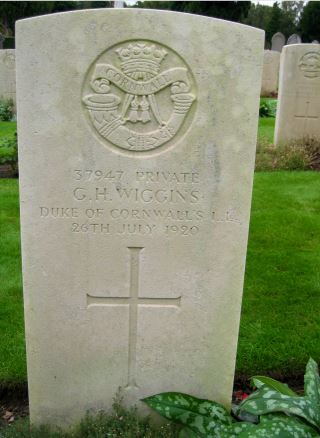3rd Battalion, Duke of Cornwall’s Light Infantry

George Henry Wiggins was born in Gloucester in 1899, the son of James Wiggins (1853-1945) and his wife Louisa (née Davis: 1873-1922). By the time of the 1911 Census the couple had had thirteen children, of whom only seven were living at that time. George was the third eldest of the four surviving boys.
Although born in Gloucester, by the time of the 1901 Census the family was living in Risca, Monmouthshire, where James was employed as a coal miner. The family had moved to 8 Exhibition Road, in the Llanthony district of Gloucester by 1911, although James was lodging in Risca and still working as a miner.
Possibly the absence of his father was a factor in young George getting in trouble with the law at the age of 11/12. The Gloucestershire Echo of 13 February 1911 reported his attendance at a Children’s Court, where he was charged and convicted of stealing watches and a chain from a neighbour’s house. Four years later the same newspaper’s 24 February 1915 edition reported another appearance in front of the Children’s Court to answer a charge of breaking into a warehouse in Stroud Road, Gloucester and stealing a quantity of butter, bacon, sugar, matches and candles, the property of the Gloucester Co-Operative & Industrial Society. He was convicted and his punishment was strokes of the birch. In mitigation his mother stated that her husband (James) was a prisoner-of-war in Germany.
Between 1911 and the outbreak of war James must have left coal mining and taken a job with the Bristol Steam Navigation Company, whose trading vessels plied between Gloucester and Continental ports. He was part of the crew of the SS Sappho which was in dock at Hamburg on the 4 August 1914. The vessel was seized by the Germans and the crew interned in Ruhleben Camp, near Spandau, Berlin. James was released in 1916, as part of an agreement to repatriate merchant seamen over the age of 55 (James would have been 63). It is uncertain if James returned to live in Exhibition Road, as he appears to have had some association with Bath Buildings, Stroud Road, Gloucester.
Perhaps encouraged by his parents to avoid any further criminal activities George, now aged 16, attested for military service into the Forage Department of the Army Service Corps (ASC) (and was given the number F28510), on 23 March 1916. He was still living at Exhibition Road. He served only 149 days, being discharged on 18 August 1916 as ‘his services being no longer required’. He did, however, leave with a ‘good character ’ endorsement. The Forage Department arranged the supply of hay and straw for equine transport.
Some papers relating to this ASC service have survived but none relating to his later service with the Duke of Cornwall’s Light Infantry (DCLI). Following the passing of the Military Service Act in January 1916 George would have been liable for compulsory military service from 1917, when he reached the age of 18. According to the Medal Rolls for the DCLI he first joined the 1/5th Battalion, with the number 37947. This was a Pioneer battalion serving in 61 Division and he is likely to have been sent to the Western Front with them in the spring of 1918 (the age for service abroad had been reduced to 18 years and six months in March 1918). According to Soldiers Died in the Great War there were no casualties to men with similar numbers to 37947 until April 1918. After service with the 1/5th Battalion he joined the 1st Battalion of the DCLI and this may have been post Armistice — in the absence of a Service Record it is not possible to verify. After this, probably due to some medical condition he was transferred to the 3rd (Reserve) Battalion, who were UK based and acted as the Portsmouth Garrison.
According to the Register of Soldiers’ Effects Private George Henry Wiggins died at the Royal Victoria Hospital, Netley, Southampton on 26 July 1920, aged 21; the cause of death is unknown. The Gloucester Journal of 7 August 1920 reported that his funeral had taken place on 3 August 1920 at Gloucester Old Cemetery, where he now lies, his grave marked with a standard CWGC headstone.
Researched by Graham Adams 3 March 2020
